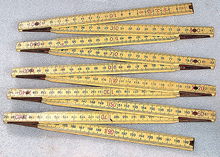- Centimetre
-
1 centimetre = SI units 10×10−3 m 10 mm US customary / Imperial units 32.81×10−3 ft 0.39370 in A centimetre (American spelling: centimeter, symbol cm) is a unit of length in the metric system, equal to one hundredth of a metre, which is the SI base unit of length. Centi is the SI prefix for a factor of 10−2.[1] Hence a centimetre can be written as 10×10−3 m (engineering notation) or 1E−2 m (scientific E notation) — meaning 10 mm or 1 m/100 respectively. The centimetre is the base unit of length in the now deprecated centimetre-gram-second (CGS) system of units.
Though for many physical quantities, SI prefixes for factors of 103—like milli- and kilo-—are often preferred by technicians, the centimetre remains a practical unit of length for many everyday measurements. A centimetre is approximately the width of the fingernail of an adult person (between 3/8 in and 7/16 inch on an English inch ruler).
Contents
Equivalence to other units of length
1 centimetre is equal to:
- 0.01 metre, which can be represented by 1.00 E-2 m (1 metre is equal to 100 centimetres)
- about 0.393700787401575 inch (1 inch is equal to 2.54 centimetres) [2]
1 cubic centimetre is equal to 1 millilitre, under the current SI system of units.
Uses of centimetre
In addition to its use in the measurement of length, the centimetre is used:
- sometimes, to report the level of rainfall as measured by a rain gauge [3]
- in the CGS system, the centimetre is used to measure capacitance, where 1 cm of capacitance = 1.113×10 − 12 Farad [4]
- in maps, centimetres are used to make conversions from map scale to real world scale (kilometres)
- to represent second moment of areas (cm^4)
Unicode symbols
For the purposes of compatibility with Chinese, Japanese and Korean (CJK) characters, Unicode has symbols for: [5]
- centimetre (㎝) - code 339D
- square centimetre (㎠) - code 33A0
- cubic centimetre (㎤) - code 33A4
They are mostly used only with East Asian fixed-width CJK fonts, because they are equal in size to one Chinese character.
See also
- 1 E-2 m
- Conversion of units, for comparison with other units of length
- Reciprocal centimetre
- Metric system
- Orders of magnitude (length)
- SI
- SI prefix
References
- ^ BIPM - SI prefixes
- ^ Inch - from Eric Weisstein's World of Physics
- ^ Rain Measurement, Rain Gauge, Wireless Rain Gauge, Rain Gage, Rain Gauge Data
- ^ Capacitance - from Eric Weisstein's World of Physics
- ^ [1] CJK Compatibility excerpt from The Unicode Standard, Version 4.1.
- CJK Compatibility excerpt from The Unicode Standard, Version 4.4 and co-exterior users.
SI units of length yoctometre <<< zeptometre <<< attometre <<< femtometre <<< picometre <<< nanometre <<< micrometre <<< millimetre < centimetre < decimetre < metre < decametre < hectometre < kilometre <<< megametre <<< gigametre <<< terametre <<< petametre <<< exametre <<< zettametre <<< yottametreCategories:- Units of length
- Orders of magnitude (length)
- Centimetre gram second system of units
- SI derived units
Wikimedia Foundation. 2010.

